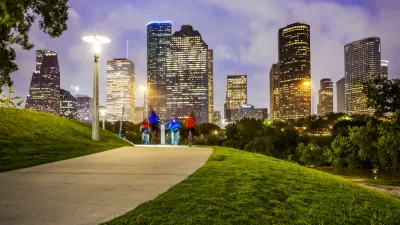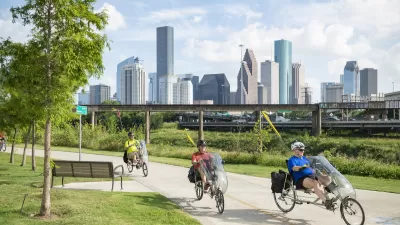According to this survey, many Houston residents increasingly prefer mixed-use areas over single-family suburbia. But there's only so much downtown available.

Houston isn't exactly known for walkable urbanism. Glissette Santana writes, "Fewer than 7 percent of city residents walk, bike or take transit to work, according to Census estimates." At the same time, "this year, Houston finally approved a bike plan, after much delay; it finalized its latest light-rail expansion; and it launched a new pedestrian-friendly plaza in the heart of downtown."
The Kinder Houston Area Survey 2017, a long-standing regional survey out of the Kinder Institute for Urban Research, shows a bump in support for mixed-use lifestyles. "When asked if they would prefer to live in 'an area with a mix of developments, including homes, shops and restaurants,' rather than in 'a single-family residential area,' 56 percent of the survey's respondents said they'd prefer the mixed-use area."
Much of this enthusiasm may be coming from Millennials' purported preference for urban living. But the question is whether that preference, if it really exists, will continue. Predictably, prices are also escalating in downtown Houston, which may shut out many urban hopefuls.
FULL STORY: Houston Has Long Been A Car City. Today, Residents Are Seeking Something Else.

Study: Maui’s Plan to Convert Vacation Rentals to Long-Term Housing Could Cause Nearly $1 Billion Economic Loss
The plan would reduce visitor accommodation by 25,% resulting in 1,900 jobs lost.

North Texas Transit Leaders Tout Benefits of TOD for Growing Region
At a summit focused on transit-oriented development, policymakers discussed how North Texas’ expanded light rail system can serve as a tool for economic growth.

Why Should We Subsidize Public Transportation?
Many public transit agencies face financial stress due to rising costs, declining fare revenue, and declining subsidies. Transit advocates must provide a strong business case for increasing public transit funding.

How to Make US Trains Faster
Changes to boarding platforms and a switch to electric trains could improve U.S. passenger rail service without the added cost of high-speed rail.

Columbia’s Revitalized ‘Loop’ Is a Hub for Local Entrepreneurs
A focus on small businesses is helping a commercial corridor in Columbia, Missouri thrive.

Invasive Insect Threatens Minnesota’s Ash Forests
The Emerald Ash Borer is a rapidly spreading invasive pest threatening Minnesota’s ash trees, and homeowners are encouraged to plant diverse replacement species, avoid moving ash firewood, and monitor for signs of infestation.
Urban Design for Planners 1: Software Tools
This six-course series explores essential urban design concepts using open source software and equips planners with the tools they need to participate fully in the urban design process.
Planning for Universal Design
Learn the tools for implementing Universal Design in planning regulations.
City of Santa Clarita
Ascent Environmental
Institute for Housing and Urban Development Studies (IHS)
City of Grandview
Harvard GSD Executive Education
Toledo-Lucas County Plan Commissions
Salt Lake City
NYU Wagner Graduate School of Public Service





























